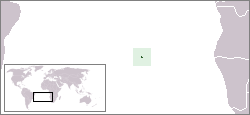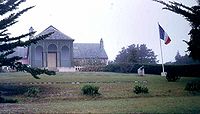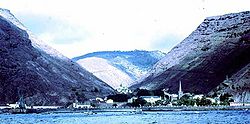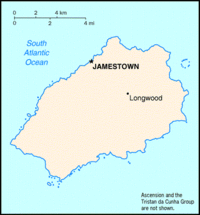Saint Helena, Ascension and Tristan da Cunha
| Saint Helena | |||||
| |||||
| Motto: "Loyal and Unshakeable" | |||||
| Anthem: "God Save the Queen" "My Saint Helena Island" (unofficial) | |||||
| Capital | Jamestown | ||||
|---|---|---|---|---|---|
| Official languages | English | ||||
| Government | UK overseas territory | ||||
| - Queen | Elizabeth II | ||||
| - Governor | Michael Clancy | ||||
| UK overseas territory | |||||
| - Charter granted | 1659 | ||||
| Area | |||||
| - Total | 425 km² 164 sq mi | ||||
| Population | |||||
| - 2005 estimate | 3,926 | ||||
| - n/a census | n/a | ||||
| - Density | 18.1/km² 46.9/sq mi | ||||
| Currency | Saint Helenian pound (SHP)
| ||||
| Time zone | GMT (UTC+0) | ||||
| Internet TLD | .sh | ||||
| Calling code | +290 | ||||
Saint Helena, named after St. Helena of Constantinople since it was sighted on her feast day, is an island of volcanic origin in the South Atlantic Ocean. A British overseas territory, it consists of the island of Saint Helena, as well as the dependencies of Ascension Island and Tristan da Cunha.
Saint Helena is famous for being Napoleon Bonaparte's place of exile between 1815 and his death in 1821. Longwood House, where Napoleon stayed, and Sane Valley, where he was buried, are owned by the French government, which was given them in 1858.
From about 1600 the island was well known by captains from Portugal, England, France, and Holland. The island was used for collecting food and as a rendezvous point for homebound voyages from Asia.
Geography
Saint Helena has a total area of 158 square miles (410 km²). It consists of three island groups: Saint Helena itself, Ascension Island, and Tristan da Cunha. Each island group has its own distinct geography.
Saint Helena is one of the most isolated places in the world, located more than 1,200 miles (2,000 km) from the nearest major landmass. As there is currently no airport on Saint Helena, travel to the island is by ship only. The RMS Saint Helena berths in James Bay approximately thirty times per year. The British government announced plans to construct an airport in Saint Helena in 2005. The airport is expected to be completed by 2010.
Saint Helena
Saint Helena, 10.5 miles (17 km) long and 6.5 miles (10 km) wide, has rugged, volcanic terrain. Its area is 47 square miles (122 sq km). There are several rocks and islets off the coast, including Castle Rock, Speery Island, The Needle, Lower Black Rock, Upper Black Rock (South), Bird Island (southwest), Black Rock, Thompson's Valley Island, Peaked Island, Egg Island, Lady's Chair, Lighter Rock (West), Long Ledge (Northwest), Shore Island, George Island, Rough Rock Island, Flat Rock (East), The Buoys, Sandy Bay Island, The Chimney, White Bird Island and Frightus Rock (southeast), all of which are within one kilometer of the shore.
The center of Saint Helena is covered by forest, some of which has been replanted, including the new Millennium Forest Project.
The highlands are two to three degrees cooler and get a few more inches of rainfall annually than the rest of the island. They are more tropical in nature and contain most of the island's endemic flora, fauna, insects, and birds. The coastal areas are barren, covered in volcanic rock, and warmer and drier than the center of the island.
When the island was discovered it was covered with indigenous vegetation, including the remarkable cabbage tree species of St Helena. The flora of Saint Helena contain a high proportion of endemic species. The island's interior must have once been a dense subtropical forest, but the coastal areas were probably quite green as well. The modern landscape is very different, with a lot of naked rock in the lower areas and an interior that owes its lushness to imported vegetation. The dramatic change in landscape must be attributed to the introduction of goats and new vegetation. As a result, the string tree (Acalypha rubrinervis) and the St. Helena olive (Nesiota elliptica) are now extinct, and many of the other endemic plants are threatened with extinction.
Ascension
Ascension Island includes the main island and several uninhabited tiny satellite islands and rocks such as Boatswain Bird Island, Boatswain Bird Rock (east), White Rocks (south), and Tartar Rock. The main island has an area of approximately 35 square miles and is formed by volcanic peaks rising from just west of the mid-Atlantic Ridge known as Green Mountain.
Most of the island is a moonscape of rugged black lava flows and red wind-whipped cinder cones. Where lava has penetrated to the ocean a striking seashore is dotted with white sand. The climate is subtropical, with temperatures at the coast ranging from about 68 to 88 degrees Fahrenheit (20 to 31 degrees Celsius).
Tristan da Cunha
Tristan da Cunha includes the main Tristan da Cunha Island — the world's most remote inhabited island — and several other uninhabited islands: Gough Island, Inaccessible Island, and the three Nightingale Islands. The islands are all mountainous and volcanic. Queen Mary's Peak on Tristan da Cunha at 2,062 m (6,765 ft) is the highest peak.
Administrative divisions
Administratively, the territory is divided into three areas:
| Group | Type | Area (km²) | Area (sq mi) | Population | Capital |
|---|---|---|---|---|---|
| Saint Helena | administrative area | 122 | 47 | 3,751 | Jamestown |
| Ascension | dependency | 88 | 34 | 1,122 | Georgetown |
| Tristan da Cunha | dependency | 200 | 77 | 284 | Edinburgh of the Seven Seas |
| Total | 410 | 158 | 6,563 | Jamestown | |
History
The island was discovered on May 21, 1502, by the Portuguese navigator João da Nova and named after Helena of Constantinople. The Portuguese found it uninhabited and over time built a chapel and some houses, although no permanent settlement was founded. The Portuguese introduced goats as a source of meat and planted lemon trees for future ship crews, a number of whom were left on the island to recover from scurvy and other ailments.
Fernando Lopez was the first long-term resident - a Portuguese prisoner who escaped from a ship about 1515 and, apart from a brief return journey to meet the pope, lived on the island until his death in 1545.
Thomas Cavendish became the first Englishman to visit the island, on his return from an expedition to circumnavigate the globe (1586-1588). His second attempt met with failure and he died at sea on his return trip at the age of 32.
From about 1600 the island was well known by captains from Portugal, England, France, and Holland. The island was used for collecting food and as a rendezvous point for homebound voyages from Asia. Sometimes ships waited near the island when their captains were hoping to pirate hostile richly laden ships. In 1775 Captain Cook visited the island on his second voyage round the world.
The Dutch claimed the island between 1645 and 1659, when it was settled by the English East India Company. A permanent settlement — of British colonists and black slaves — was founded at Jamestown, named after James, Duke of York (later King James II). The English East India Company used the island as a revictualing station, primarily on the long return voyage from India via the Cape of Good Hope. By 1673 nearly half the inhabitants were imported slaves, but between 1826 and 1836 all slaves were freed.
The Dutch retook the island in 1673 but were ejected by the English navy after two months. The island was regranted to the East India Company.
In 1815 the British government selected Saint Helena as the place of detention of Napoleon Bonaparte. He was brought to the island in October of that year and lodged at The Briars, outside Jamestown. In December he was moved to Longwood, where he died in 1821. (His body was returned to France in 1840.)
During the period the island was strongly garrisoned. The British also took control of Ascension Island and Tristan da Cunha at this time, to prevent any French attempts to free Napoleon being launched from these nearby territories. After Napoleon's death the East India Company resumed full control of Saint Helena until April 22, 1834, when it was vested in the British Crown.
In 1810, the first Chinese indentured laborers arrived on the island. In 1840, a Vice Admiralty Court was set up to deal with vessels captured in the slave trade, and more than ten thousand slaves were liberated.
During the Second Boer War (1899–1902), the British military, fearing that Boer prisoners of war might be freed by sympathizers in South Africa, detained around 5,000 POWs on the island.
As a port of call on the long route to the Cape Colonies and India, the island enjoyed prosperity, until construction of the Suez Canal reduced the need for long voyages via the Cape of Good Hope. During World War II, Ascension Island was leased to the United States, which constructed a large airbase.
After World War II, the prosperity of the Island and its dependencies decreased. A visit by the Duke of Edinburgh to Ascension, Saint Helena, and Tristan da Cunha for a time raised the profile of the islands. In 1999, the British government announced plans to construct an airport on Saint Helena to bolster the island's economy and reduce dependence on boats for supplies. The airport is scheduled to open in 2010, when the Royal Mail ship is expected to cease operations.
Demographics
Saint Helena has a small population of a couple of thousand inhabitants, mainly descended from people from West and Southern Africa, the British Isles, and Scandinavia. The island's population is one-half African, one-quarter Chinese, and one-quarter white. In recent decades, many have migrated to the Falkland Islands or the United Kingdom.
According to statistics in the 2007 Yearbook of Jehovah's Witnesses, Saint Helena has the largest proportion of Jehovah's Witnesses of any country or territory in the world: one person in thirty (129 people).
Tristan da Cunha has a population of about three hundred inhabitants of mainly British descent. Christianity is the main religion, with the largest denominations being Anglican and Roman Catholic.
Ascension Island has no native inhabitants. A transient population of approximately three thousand lives on the Island, made up mainly of members of the American and British military, civilian contractors who serve on the joint Anglo-American airbase, and members of their families (a few of whom were born on the island).
The citizens of Saint Helena and its dependencies hold British Overseas Territories citizenship. On May 21, 2002, they were granted access to full British citizenship.
Economy
Until 1966, the island had a monocrop economy based on the cultivation and processing of New Zealand flax for rope and string. St Helena's economy is now very weak, and the island is almost entirely sustained by aid from London. Saint Helena also produces what is said to be the most expensive coffee in the world.
The Saint Helena tourist industry is heavily based around the promotion of Napoleon's imprisonment. A golf course also exists, and the possibility for sport fishing tourism is great.
Ascension Island, Tristan da Cunha, and Saint Helena all issue their own postage stamps, which provide a significant income.
Saint Helena also produces and exports Tungi Spirit, made from the fruit of the prickly or cactus pears, Opuntia vulgaris. Tungi is the local name for the prickly or cactus pear.
The Saint Helenian pound, the local currency, is on a par with the Pound Sterling. The government of Saint Helena produces its own coinage and banknotes. The first coin was a half penny produced by the East India Company in 1821. It remains readily available to collectors.
The territory has its own bank, the Bank of St. Helena, which has two branches: in Jamestown on Saint Helena and Georgetown, Ascension Island.
Politics
Executive authority in Saint Helena is invested in Queen Elizabeth II and is exercised on her behalf by the governor, who is appointed by the Queen on the advice of the British government. Defense and foreign affairs remain the responsibility of the United Kingdom.
There are fifteen seats on the Legislative Council, a unicameral legislature. Twelve of the fifteen members are elected in elections held every four years. The other three members are the governor and two ex officio officers. The Executive Council consists of the governor, two ex officio officers, and six elected members of the Legislative Council appointed by the governor. There is no elected chief minister, and the governor acts as the head of government.
Both Ascension Island and Tristan da Cunha have an administrator appointed to represent the governor of Saint Helena.
Sources and further reading
External links
- The official St Helena National Trust Website
- TUNGI 'The spirit of St Helena' A locally made spirit from pricky pear fruit
- The first website on St Helena — since 1995
- The Official Government Website of Saint Helena
- The Official Government Website of Ascension Island
- The Official Tristan da Cunha Website
- Saint Helena Online St Helena Web Portal covering all key links, news, and general exchanges about the Island of St Helena.
- The Friends of St Helena A UK society promoting education about the island.
- The St Helena Institute A focal point for academic research into St Helena and dependencies; incl. lists of publications and information on family history.
- The French possessions on St Helena
- Saint Helena Geographical research on the sense of identity of the St Helenians
- Bank of Saint Helena Banking services for Saint Helena and Ascension Island
- Saint FM St Helena radio station with live streaming audio
- Education on St Helena All aspects of education for St Helena
- Open Directory Project — Saint Helena directory category
Credits
New World Encyclopedia writers and editors rewrote and completed the Wikipedia article in accordance with New World Encyclopedia standards. This article abides by terms of the Creative Commons CC-by-sa 3.0 License (CC-by-sa), which may be used and disseminated with proper attribution. Credit is due under the terms of this license that can reference both the New World Encyclopedia contributors and the selfless volunteer contributors of the Wikimedia Foundation. To cite this article click here for a list of acceptable citing formats.The history of earlier contributions by wikipedians is accessible to researchers here:
The history of this article since it was imported to New World Encyclopedia:
Note: Some restrictions may apply to use of individual images which are separately licensed.






